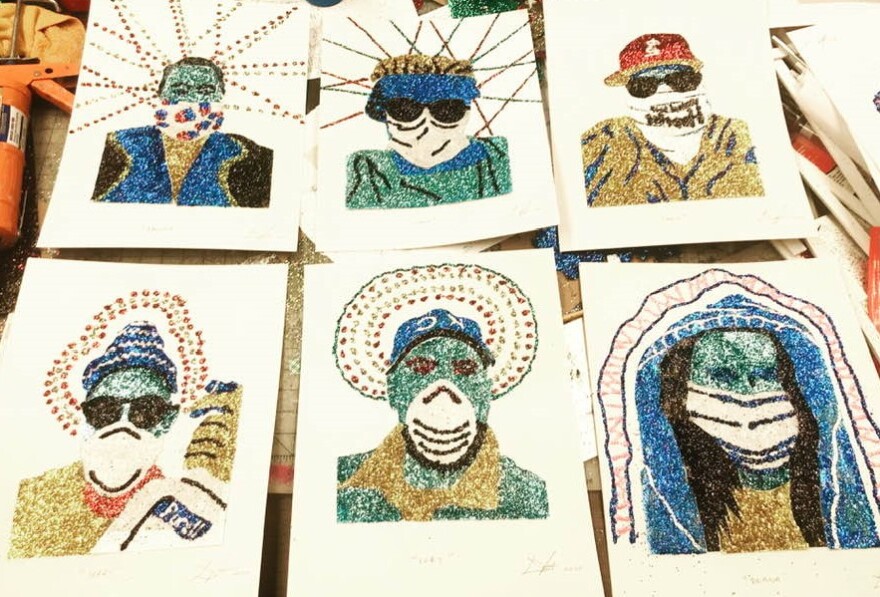Now that the CDC has officially urged Americans to cover their noses and mouths when outside their homes, more Kansas Citians are doing just that, and what used to be an unusual sight — a person in a mask outside a medical setting — has quickly become the norm.
We're learning to navigate all kinds of logistical details, like how to prevent our glasses fogging up and how to adjust our speaking volume, but we're also wrestling with something deeper: How to communicate goodwill to people while standing at least six feet away, without being able to smile. Did we realize, before, how much work our smiles did for us every day?

At the grocery store or in the park, we do a subtle dance, finding ways to be friendly while maintaining our distance. It's hard to show how we feel. It's hard to tell how anyone else feels. Is that person in line behind us annoyed? Scowling? Smiling in solidarity? It's in their eyes. It's in their posture. But those things aren't as easy to read.
Artist Dylan Mortimer is used to moving through the world this way. He's had a rare genetic respiratory condition called Cystic Fibrosis all his life. In the last three years, he's had two lung transplants. "Post-transplant, you have to wear a mask," he explains. "So this has been my heavy reality for the past three years."

He used to get funny looks while wearing his mask out and about. He'd sometimes take a risk and pull down his mask to show a smile, to put someone else at ease, to establish a connection, even though it wasn't the safest choice. But as most of us are learning, these uneasy gambles can be part of getting through the day.
Seeing so many people suddenly posting masked selfies on social media was poignant for Mortimer. He felt a rush of companionship after a long, lonely journey, but he also felt sadness. "It's like, they came to this party, and I'm so happy to see them, but no one ever wanted to be here," Mortimer says. Inspired, he asked people to send him their selfies for an art project called Masked Like Me.
To Mortimer, all the people wearing masks right now are warriors. He makes the portraits glittery, to celebrate the herculean efforts people are putting into even the smallest things right now.
"What we're all trying to figure out is how to function and communicate and do economics and politics with these new barriers between us," Mortimer notes.
Gloria Baker Feinstein is a photographer with Kansas City roots, and she too is intrigued by masked faces. She's recently started working with a Portland-based seamstress to put photographs of the bottom halves of people's faces onto masks, to recreate the illusion of a whole face. She's calling the project Face In Place.
In a Facebook post promoting sales, Feinstein asks, "Do people not recognize you anymore when you're out and about? Put yourself on your mask!"
As a photographer, Feinstein has always studied faces, so she can read them well enough to get the information she needs, even when all she has to work with is the arc of a brow. Lately, she's found herself filling in what's missing. "I play a bit of a guessing game as I try to fill in the blanks, to imagine the missing pieces of the puzzle," she says.
Feinstein urges Face In Place customers to send photographs that convey a range of emotions, so they can pick a mask to match any mood. But most people stick with a neutral, relaxed expression, which intrigues her. It seems to be less about wanting to show how they feel, she says, and more about wanting to be seen, period.
"The masks have appealed to those who want others to know they are all there," says Feinstein, "that they're not keeping or hiding anything."
And that's been part of the surprise to Dylan Mortimer, as his collection of masked selfies from friends and family continues to grow. It's hard, sometimes, to tell one masked person from another. The mask somehow stands in the way of full recognition.
"I'll complete a portrait and be like, 'Wait... who is this again?'" he says.
So although Mortimer started out seeking uniformity in the series — just people posing in masks, nothing more — he now loves the images where something is happening. His own dad in a mask, playing a guitar. A masked couple getting engaged, with a ring front and center. At first he worried those pictures would break the mold. Now he's glad they do that.
"OK, there’s a mask," Mortimer says, "but there’s something else going on, too. Life is still happening."
Copyright 2021 KCUR 89.3. To see more, visit KCUR 89.3. 9(MDA3OTgyNDI4MDEzMTM0MjQzMTZlNDI0Mg004))








